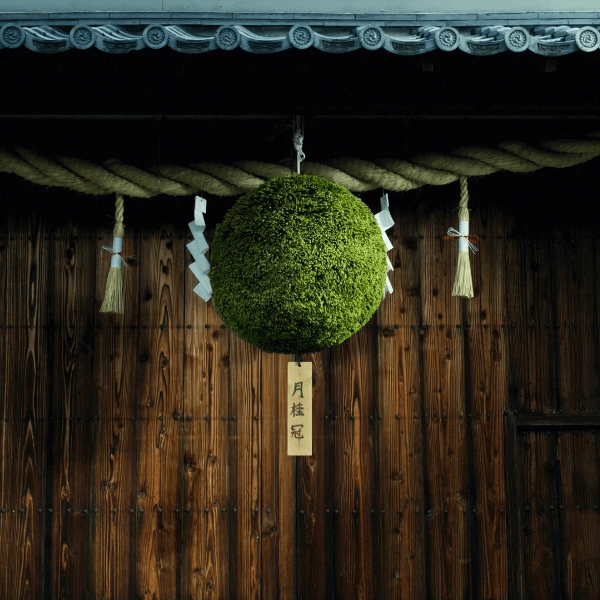The "Path of Faith,” Still Trod Today
The lane to Fushimi Church still exists
In the Hoko Fushimijo no Zu map of the castle town of Fushimi, the building which used to be Fushimi Church, which was connected with Takayama Ukon, is shown as entered from a lane to the west. Based on the book by Professor Emeritus Mitsumata Shunji of Kyoto Seibo College, Gekkeikan has been able to confirm that on the company's land (the northeast side of the parking lot for the Gekkeikan Okura Sake Museum) there is a section that retains its 2.4 m width in the current land divisions, and heads into the grounds of Kyoto Municipal Fushimi Minamihama Kindergarten. Gekkeikan was founded in 1637, 23 years after Fushimi Church was demolished in 1614.
So why has this road to the entrance remained to the present day? According to Mr. Okura Keiichi (born 1927), who lived here as a child and serves as Gekkeikan's Executive Advisor, this was the approach to the imperial mausoleum. The imperial mausoleum he referred to is the Fushimi Shorin-in Mausoleum (Tango-cho, Fushimi-ku, Kyoto City), and still exists overlapping the northeast corner with the site labeled as “Takayama Ukon” on the Hoko Fushimijo no Zu map. In the past, there was a small building in the Fushimi Shorin-in Mausoleum grounds where worshippers could get vermillion seals impressed to record their visit. Based on Mr. Okura's statement, we obtained an official map from the government's Legal Affairs Bureau dating back to the early Showa period. From the lane to Fushimi Church, in the Gekkeikan site, there was a road directly connected to the southwest corner of the Fushimi Shorin-in Mausoleum to the east. It is believed to be this function, as the approach to the mausoleum, that enabled the road to Fushimi Jesuit Church to be retained in its original form.

The lane that led to the Fushimi Jesuit Church, labeled as Takayama Ukon's mansion [Current appearance]. In the day, Ukon would have often walked this path, and Fushimi Christians would have come to Mass here as a foundation for their souls.

A narrow lane coming in from the western side towards the buildings used as the Fushimi Jesuit Church, which was connected with Takayama Ukon.
Fushimi Shorin-in Mausoleum
The Fushimi Shorin-in Mausoleum is the resting place of Cloistered Emperor Go-Suko. Prince Sadafusa of the Fushimi-no-Miya collateral imperial house was granted the title of “cloistered emperor” in 1447 and became the Cloistered Emperor Go-Suko. Go-Suko is known to have compiled the Kanmon Gyoki diaries over some thirty years from 1416 to 1448, and these also include descriptions of the Fushimi Momoyama area as it was then.
(Reference: Kato Jiro, Fushimi Momoyama no Bunka-shi (Cultural History of Fushimi Momoyama), 1953)
The following is known about the Cloistered Emperor Go-Suko
Fushimi Palace in the Shigetsu Forest was considered the Upper Palace (Kami-no-Gosho), and near the docks and southern shore of Ogura Pond a new Lower Palace (Shimo-no-Gosho; Funato Gosho [Pier Palace]) was constructed, and Prince Sadafusa would go between the Upper and Lower Palaces, greatly enjoying the landscapes of Fushimi.
Perhaps for that reason, the tomb of the prince, who became the Cloistered Emperor Go-Suko, was located beside the present school gate of Minamihama Elementary School, and known as Shorin-in Mausoleum. To the west, a hermitage to guard the mausoleum was built where the lady-in-waiting to the prince lived as a nun. This hermitage is believed to have developed into the present Shorin-in temple. Both palaces were later burned to the ground during the subsequent wars, though the picturesque scenery created by Shigetsu Forest and Ogura Pond remained known for generations.
(Source: Kuriyama Kazuhide, Rakumi No. 518, issued Nov. 10, 1995)

Fushimi Shorin-in Mausoleum, the tomb of the Cloistered Emperor Go-suko of the Muromachi period. The Kanmon Gyoki diaries are known to have been written by Go-suko. Photographed with the permission of the Momoyama Regional Office for Imperial Mausolea and Tombs of the Imperial Household Agency's Archives and Mausolea Department.
Faith nestles close over the ages
The approach to the mausoleum where the Cloistered Emperor Go-Suko was interred was registered in 1909 by the Forestry Bureau of the Imperial Household Ministry, which managed the forests belonging to the imperial family. The following year, 1910, ownership was transferred to Fushimi Town, and the elementary school and kindergarten were transferred here. From statements, we can know that by the early Showa period at least, there was an approach path from the road towards Gekkeikan (what is now the parking space for the Gekkeikan Okura Sake Museum) stretching towards the mausoleum. In later years, the route to the school and kindergarten running north-south to the west of the mausoleum became the main route, and buildings for the kindergarten were erected around the old approach to the mausoleum. Ownership of the site was also settled, and a wall was built along the boundary between the kindergarten and Gekkeikan, near the entrance to the church building, to separate them. The parking lot in front of the Gekkeikan Okura Sake Museum is where a number of wooden buildings, including warehouses and merchant-style wooden houses, stood in two rows. Later, a reinforced concrete employee dormitory was built, and as its outer perimeter was enclosed by a wall, it was no longer easy to see where the old lane was. Recently, with the development of the museum's parking lot, the existence of the narrow lane has been revealed.
As the times change, the lane to Fushimi Jesuit Church has changed its role from being an approach to a Christian site to a Shinto one, with the construction of the imperial mausoleum, and there is also a Jodo Buddhist temple, the Shorin-in, standing to the north, recreated from the original hermitage built for the nun who was the lady-in-waiting to the Cloistered Emperor Go-Suko. Perhaps, with all these different faiths over the years, this lane could be called the “Path of Faith.”
[Major Reference Work]
- Mitsumata Shunji, “Fushimi Kirishitan Shiseki Kenkyu” (A Study of the Historic Sites of Fushimi Christians), Kyoto Seibo College Fushimi Studies Society, ed. Fushimi no Rekishi to Bunka (History and Culture of Fushimi) (Kyo/Fushimi Monographs Collection 1), Seibundo, 2003.
[References Related to Takayama Ukon]
- Ebisawa Arimichi, Takayama Ukon (Biography Monographs) [New Edition], Yoshikawa Kobunkan, 2009.
- Shimazaki Kenji, Kirishitan Daimyo Takayama Ukon no Ashiato o Aruku - Yukari no chi shashin-shu (Walking in the Footsteps of the Christian Daimyo Takayama Ukon: Photo album of places connected with him), Sangaku Publishing, 2014.
- Nakanishi Yuki, ed., Takayama Ukon Kirishitan Daimyo e no Shin Shiten (Christian Daimyo Takayama Ukon: A new perspective), Miyaobi Publishing, 2014.
- Hubert Cieslik, Takayama Ukon Shiwa (Historical Stories of Takayama Ukon), Seibo Bunko, 2012.
- Furusu Kaoru (supervised by the Special Committee for Promoting Canonization and Beatification, Catholic Bishops' Conference of Japan), Yusuto Takayama Ukon - Ima, Orite Iku Hito e (Justo Takayama Ukon: To those who abandon ambition), Don Bosco Sha, 2014.
The designs used in this corner include images photographed by Gekkeikan with the permission of the Catholic Takatsuki Church (2-26 Nomi-cho, Takatsuki City, Osaka).






